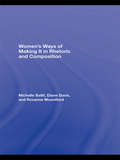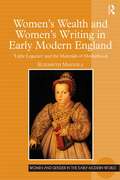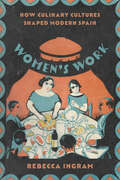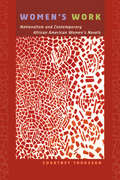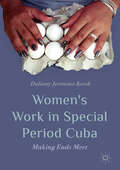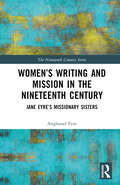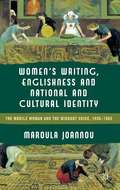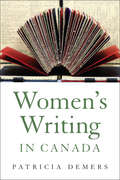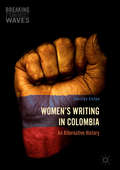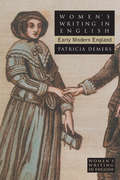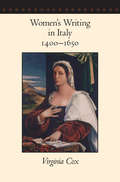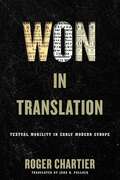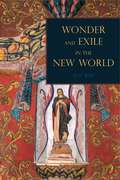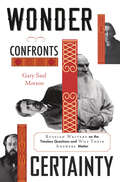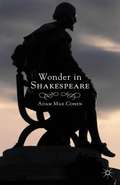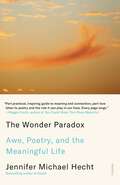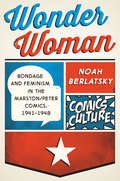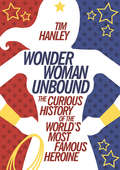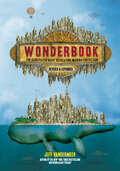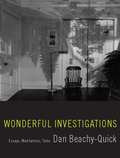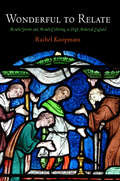- Table View
- List View
Women’s Ways of Making
by Maureen Daly Goggin Shirley K RoseWomen’s Ways of Making draws attention to material practices—those that the hands perform—as three epistemologies—an episteme, a techne, and a phronesis—that together give pointed consideration to making as a rhetorical embodied endeavor. Combined, these epistemologies show that making is a form of knowing that (episteme), knowing how (techne), and wisdom-making (phronesis). Since the Enlightenment, embodied knowledge creation has been overlooked, ignored, or disparaged as inferior to other forms of expression or thinking that seem to leave the material world behind. Privileging the hand over the eye, as the work in this collection does, thus problematizes the way in which the eye has been co-opted by thinkers as the mind’s tool of investigation. Contributors to this volume argue that other senses—touch, taste, smell, hearing—are keys to knowing one’s materials. Only when all these ways of knowing are engaged can making be understood as a rhetorical practice. In Women’s Ways of Making contributors explore ideas of making that run the gamut from videos produced by beauty vloggers to zine production and art programs at women’s correctional facilities. Bringing together senior scholars, new voices, and a fresh take on material rhetoric, this book will be of interest to a broad range of readers in composition and rhetoric. Contributors: Angela Clark-Oates, Jane L. Donawerth, Amanda Ellis, Theresa M. Evans, Holly Fulton-Babicke, Bre Garrett, Melissa Greene, Magdelyn Hammong Helwig, Linda Hanson, Jackie Hoermann, Christine Martorana, Aurora Matzke, Jill McCracken, Karen S. Neubauer, Daneryl Nier-Weber, Sherry Rankins-Roberson, Kathleen J. Ryan, Rachael Ryerson, Andrea Severson, Lorin Shellenberger, Carey Smitherman-Clark, Emily Standridge, Charlese Trower, Christy I. Wenger, Hui Wu, Kathleen Blake Yancey
Women's Ways of Making It in Rhetoric and Composition
by Michelle Ballif Roxanne Mountford D. DavisThis volume explores how women in the fields of rhetoric and composition have succeeded, despite the challenges inherent in the circumstances of their work. Focusing on those women generally viewed as "successful" in rhetoric and composition, this volume relates their stories of successes (and failures) to serve as models for other women in the profession who aspire to "make it," too: to succeed as women academics in a sea of gender and disciplinary bias and to have a life, as well. Building on the gains made by several generations of rhetoric and composition scholars, this volume provides strategies for a newer generation of scholars entering the field and, in so doing, broadens the support base for women in the field by connecting them with a greater web of women in the profession. Offering frank discussion of professional and personal struggles as well as providing reference materials addressing these concerns, solid career advice, and inspirational narratives told by women who have "made it" in the field of rhetoric and composition, this work highlights such common concerns as: dealing with sexism in the tenure and promotion process, maintaining a balance between career and family, struggling for scholarly and/or administrative respect, mentoring junior women, finding one’s voice in scholarship, and struggling to say "no" to unrewarded service work. The profiles of individual successful women describe each woman’s methods for success, examine the price each has paid for that success, and pass along the advice each has to offer other women who are beginning a career in the field or attempting to jumpstart an existing career. With resources and general advice for women in the field of rhetoric and composition to guide them through their careers—as they become, survive, and thrive as professionals in the discipline – this book is must-have reading for every woman making her career in the rhetoric and composition fields.
Women's Wealth and Women's Writing in Early Modern England: 'Little Legacies' and the Materials of Motherhood (Women and Gender in the Early Modern World)
by Elizabeth MazzolaFocusing on both literary and material networks in early modern England, this book examines the nature of women's wealth, its peculiar laws of transmission and accumulation, and how a world of goods and favors, mothers and daughters was transformed by market culture. Drawing on the long and troubled relationship between Elizabeth Tudor, Mary Stuart, Bess of Hardwick, and Arbella Stuart, Elizabeth Mazzola more broadly explores what early modern women might exchange with or leave to each other, including jewels and cloth, needlework, combs, and candlesticks. Women's writings take their place in this circulation of material things, and Mazzola argues that their poems and prayers, letters and wills are particularly designed with the aim of substantiating female ties. This book is an interdisciplinary one, making use of archival research, literary criticism, social history, feminist theory, and anthropological studies of gift exchange to propose that early modern women - whatever their class, educational background or marital status - were key economic players, actively pursuing favors, trading services, and exchanging goods.
Women’s Work: How Culinary Cultures Shaped Modern Spain
by Rebecca IngramWe are living in a moment in which famous chefs, Michelin stars, culinary techniques, and gastronomical accolades attract moneyed tourists to Spain from all over the world. This has prompted the Spanish government to declare its cuisine as part of Spanish patrimony. Even with this widespread global attention, we know little about how Spanish cooking became a litmus test for demonstrating Spain's modernity and, relatedly, the roles ascribed to the modern Spanish women responsible for daily cooking.Efforts to articulate a new, modern Spain infiltrated writing in multiple genres and media. Women's Work offers a sharp reading of diverse sources, placed in their historical context, that yields a better understanding of the roles of food within an inherently uneven modernization process. Further, author Rebecca Ingram's perceptive critique reveals the paradoxical messages women have navigated, even in texts about a daily practice that shaped their domestic and work lives. Women's Work posits that this is significant because of the degree to which domestic activities, including cooking, occupied women's daily lives, even while issues like their fitness as citizens and participation in the public sphere were hotly debated. At the same time, progressive intellectuals from diverse backgrounds began to invoke Spanish cooking and eating as one measure of Spanish modernity.Women's Work shows how culinary writing engaged these debates and reached women at the site of much of their daily labor—the kitchen—and, in this way, shaped their thinking about their roles in modernizing Spain.
Women's Work: Nationalism and Contemporary African American Women's Novels
by Courtney ThorssonIn Women's Work, Courtney Thorsson reconsiders the gender, genre, and geography of African American nationalism as she explores the aesthetic history of African American writing by women. Building on and departing from the Black Arts Movement, the literary fiction of such writers as Toni Cade Bambara, Paule Marshall, Gloria Naylor, Ntozake Shange, and Toni Morrison employs a cultural nationalism--practiced by their characters as "women's work"--that defines a distinct contemporary literary movement, demanding attention to the continued relevance of nation in post-Black Arts writing. Identifying five forms of women's work as organizing, dancing, mapping, cooking, and inscribing, Thorsson shows how these writers reclaimed and revised cultural nationalism to hail African America.
Women’s Work in Special Period Cuba: Making Ends Meet
by Daliany Jerónimo KershThe abrupt loss of Soviet financial support in 1989 resulted in the near-collapse of the Cuban economy, ushering in the almost two decades of austerity measures and severe shortages of food and basic consumer goods referred to as the Special Period. Through the innovative framework of individual and collective memory, Daliany Jerónimo Kersh brings together analysis of press sources and oral histories to offer a compelling portrait of how Cuban women cleverly combined various forms of paid work to make ends meet. Disproportionately impacted by the economic crisis given their role as primary caregivers and household managers and unable to survive on devalued state salaries alone, women often employed informal and illegal earning strategies. As she argues, this regression into gendered work such as cooking, sewing, cleaning, reselling, and providing sexual services precipitated by the post-Soviet crisis to a large extent marked a return to pre-revolutionary gendered divisions of labor.
Women’s Writing and Mission in the Nineteenth Century: Jane Eyre’s Missionary Sisters (The Nineteenth Century Series)
by Angharad EyreUntil now, the missionary plot in Charlotte Brontë’s Jane Eyre has been seen as marginal and anomalous. Despite women missionaries being ubiquitous in the nineteenth century, they appeared to be absent from nineteenth-century literature. As this book demonstrates, though, the female missionary character and narrative was, in fact, present in a range of writings from missionary newsletters and life writing, to canonical Victorian literature, New Woman fiction and women’s college writing. Nineteenth-century women writers wove the tropes of the female missionary figure and plot into their domestic fiction, and the female missionary themes of religious self-sacrifice and heroism formed the subjectivity of these writers and their characters. Offering an alternative narrative for the development of women writers and early feminism, as well as a new reading of Jane Eyre, this book adds to the debate about whether religious women in the nineteenth century could actually be radical and feminist.
Women’s Writing, Englishness and National and Cultural Identity
by Maroula JoannouAn original mapping of women's writing in the 1940s and 1950s, this book looks at Englishness and national identity in women's writing and includes writing from Scotland, Wales, Ireland the Indian subcontinent and Africa. The authors discussed include Virginia Woolf, Daphne Du Maurier, Doris Lessing and Muriel Spark.
Women’s Writing in Canada (Women's Writing in English)
by Patricia DemersSpanning the period from the Massey Commission to the present and reflecting on the media of print, film, and song, this study attends to the burgeoning energy of women writers across genres. It explores how their work interprets our national story. The questioning, disruptive feminist practice of their fiction, filmmaking, poetry, song-writing, drama, and non-fiction reveals the tensions of colonial society at the same time as it transforms cultural life in Canada. Women’s Writing in Canada resurrects foremothers who were active before and after the mid-century – Ethel Wilson, Gabrielle Roy, Gwen Pharis Ringwood, Dorothy Livesay, and P.K. Page – as well as such forgotten writers as Grace Irwin, Patricia Blondal, and Edna Jaques. Its breadth extends to the contemporary voices and influences of novelists Tracey Lindberg and Heather O’Neill, poets Marilyn Dumont and Leanne Betasamosake Simpson, playwrights Hannah Moscovitch and Anna Chatterton, and filmmakers Sarah Polley and Mina Shum. Writing for children as well as memoirs, autobiographies, comic books, and cookbooks illustrate the wide and impressive range of women’s talents.
Women's Writing in Colombia
by Cherilyn ElstonThis book provides an original and exciting analysis of Colombian women's writing and its relationship to feminist history from the 1970s to the present. In a period in which questions surrounding women and gender are often sidelined in the academic arena, it argues that feminism has been an important and intrinsic part of contemporary Colombian history. Focusing on understudied literary and non-literary texts written by Colombian women, it traces the particularities of Colombian feminism, showing how it has been closely entwined with left-wing politics and the country's history of violence. This book therefore rethinks the place of feminism in Latin American history and its relationship to feminisms elsewhere, challenging many of the predominant critical paradigms used to understand Latin American literature and culture.
Women's Writing in English
by Patricia DemersIn this introduction to the diversity and scope of the writing by women in England from the beginning of the sixteenth century to the restoration of the monarchy in 1660, Patricia Demers discusses the creative realities of women writers' accomplishments and the cultural conditions under which they wrote. There were deep suspicions and restrictions surrounding the education of women during this period, and thus the contributions of women to literature, and to the print industry itself, are largely unknown. This wide-ranging examination of the genres of early modern women's writing embraces translation (from Latin, Greek, and French) in the fields of theological discourse, romance and classical tragedy, original meditations and prayers, letters and diaries, poetry, closet drama, advice manuals, and prophecies and polemics. A close study of six major authors - Mary Sidney, Aemilia Lanyer, Elizabeth Tanfield Cary, Lady Mary Wroth, Margaret Cavendish, and Katherine Philips - explores their work as poets, dramatists, and romantic fiction writers. Demers invites readers to savour the subtlety and daring with which these women authors made writing an expressly social craft.
Women's Writing in Italy, 1400–1650
by Virginia CoxWinner, 2009 Best Book Award, Society for the Study of Early Modern WomenWinner, 2008 PROSE Award for Best Book in Language, Literature, and Linguistics. Professional and Scholarly Publishing Division of the Association of American PublishersThis is the first comprehensive study of the remarkably rich tradition of women’s writing that flourished in Italy between the fifteenth and early seventeenth centuries. Virginia Cox documents this tradition and both explains its character and scope and offers a new hypothesis on the reasons for its emergence and decline. Cox combines fresh scholarship with a revisionist argument that overturns existing historical paradigms for the chronology of early modern Italian women’s writing and questions the historiographical commonplace that the tradition was brought to an end by the Counter Reformation. Using a comparative analysis of women's activities as artists, musicians, composers, and actresses, Cox locates women's writing in its broader contexts and considers how gender reflects and reinvents conventional narratives of literary change.
Women's Writing in Middle English: An Annotated Anthology (Longman Annotated Texts)
by Alexandra BarrattWomen's writing in any period remains of critical concern, both at undergraduate and postgraduate level. Alexandra Barratt's edition offers a wide range of texts from the period 1300-1500, including: Original texts written by women in the Middle Ages Texts translated by women in the Middle Ages Prayers, meditations, scriptural comment, and accounts of religious experiences Educational writings Romance, poetry Each poem is given a headnote, giving details of composition, manuscript and sources. Full on-page annotation is provided giving details of allusions to contemporary religious, historical and social issues. A general introduction gives context to all the pieces and provides a penetrating account of the role of women in a burgeoning society of literary and cultural transmission.
Won in Translation: Textual Mobility in Early Modern Europe (Material Texts)
by Roger ChartierIn Won in Translation Roger Chartier, one of the world's leading historians of books, publishing, and reading, considers the mobility of the early modern text and the plurality of circulating versions of the same work. The agent for both is translation, for through their lexical, aesthetic, and cultural decisions, translators always assign new meaning or new status to what they translate.Won in Translation proceeds by way of four case studies, three dedicated to works originally in Spanish, the fourth to a Portuguese dramatic adaptation of Don Quixote. Bartolomé de Las Casas' Brevísima relación de la destrucción de las Indias, first printed in 1552, was a powerful instrument for the construction of what was later called the "black legend" of Spanish monarchy. Baltasar Gracián's Oráculo Manual, published in 1647, became the most famous courtier's manual in Europe. Both traveled more widely and were translated more often than any other books of their era. For Chartier they illustrate the great power of translation, which allowed Las Casas' account to be placed in multiple and successive contexts and enabled Gracián's book to take on a range of meanings it had not originally had. Chartier's next two chapters are devoted to plays, one by Lope de Vega, the other by Antônio José da Silva. In the case of Lope's Fuente Ovejuna, the "translation" was one from historical chronicle to dramatic performance. In Antônio José da Silva's Vida do Grande D. Quixote, the textual migration is twofold, as Cervantes' hero moves from Spanish to Portuguese and from novel to play.In an Epilogue, Chartier moves three centuries forward to consider the paradox that it is the absolute immobility of the text, "reinvented" word for word, that creates its mobility in Jorge Luis Borges' fiction "Pierre Menard, Author of the Quixote." Works are transformed through changes of genre or language, to be sure; but even when the texts remain fixed, their readers give them different or inverted meaning.
Wonder and Exile in the New World
by Alex NavaIn Wonder and Exile in the New World, Alex Nava explores the border regions between wonder and exile, particularly in relation to the New World. It traces the preoccupation with the concept of wonder in the history of the Americas, beginning with the first European encounters, goes on to investigate later representations in the Baroque age, and ultimately enters the twentieth century with the emergence of so-called magical realism. In telling the story of wonder in the New World, Nava gives special attention to the part it played in the history of violence and exile, either as a force that supported and reinforced the Conquest or as a voice of resistance and decolonization. Focusing on the work of New World explorers, writers, and poets—and their literary descendants—Nava finds that wonder and exile have been two of the most significant metaphors within Latin American cultural, literary, and religious representations. Beginning with the period of the Conquest, especially with Cabeza de Vaca and Las Casas, continuing through the Baroque with Cervantes and Sor Juana Inés de la Cruz, and moving into the twentieth century with Alejo Carpentier and Miguel Ángel Asturias, Nava produces a historical study of Latin American narrative in which religious and theological perspectives figure prominently.
Wonder and Exile in the New World
by Alex NavaIn Wonder and Exile in the New World, Alex Nava explores the border regions between wonder and exile, particularly in relation to the New World. It traces the preoccupation with the concept of wonder in the history of the Americas, beginning with the first European encounters, goes on to investigate later representations in the Baroque age, and ultimately enters the twentieth century with the emergence of so-called magical realism. In telling the story of wonder in the New World, Nava gives special attention to the part it played in the history of violence and exile, either as a force that supported and reinforced the Conquest or as a voice of resistance and decolonization. Focusing on the work of New World explorers, writers, and poets—and their literary descendants—Nava finds that wonder and exile have been two of the most significant metaphors within Latin American cultural, literary, and religious representations. Beginning with the period of the Conquest, especially with Cabeza de Vaca and Las Casas, continuing through the Baroque with Cervantes and Sor Juana Inés de la Cruz, and moving into the twentieth century with Alejo Carpentier and Miguel Ángel Asturias, Nava produces a historical study of Latin American narrative in which religious and theological perspectives figure prominently.
Wonder and Science: Imagining Worlds in Early Modern Europe
by Mary Blaine CampbellDuring the early modern period, western Europe was transformed by the proliferation of new worlds—geographic worlds found in the voyages of discovery and conceptual and celestial worlds opened by natural philosophy, or science. The response to incredible overseas encounters and to the profound technological, religious, economic, and intellectual changes occurring in Europe was one of nearly overwhelming wonder, expressed in a rich variety of texts. In the need to manage this wonder, to harness this imaginative overabundance, Mary Baine Campbell finds both the sensational beauty of early scientific works and the beginnings of the divergence of the sciences—particularly geography, astronomy, and anthropology—from the writing of fiction. Campbell's learned and brilliantly perceptive new book analyzes a cross section of texts in which worlds were made and unmade; these texts include cosmographies, colonial reports, works of natural philosophy and natural history, fantastic voyages, exotic fictions, and confessions. Among the authors she discusses are André Thevet, Thomas Hariot, Francis Bacon, Galileo, Margaret Cavendish, and Aphra Behn. Campbell's emphasis is on developments in England and France, but she considers works in languages other than English or French which were well known in the polyglot book culture of the time. With over thirty well-chosen illustrations, Wonder and Science enhances our understanding of the culture of early modern Europe, the history of science, and the development of literary forms, including the novel and ethnography.
Wonder Confronts Certainty: Russian Writers on the Timeless Questions and Why Their Answers Matter
by Gary Saul MorsonA noted literary scholar traverses the Russian canon, exploring how realists, idealists, and revolutionaries debated good and evil, moral responsibility, and freedom.Since the age of Tolstoy, Dostoevsky, and Chekhov, Russian literature has posed questions about good and evil, moral responsibility, and human freedom with a clarity and intensity found nowhere else. In this wide-ranging meditation, Gary Saul Morson delineates intellectual debates that have coursed through two centuries of Russian writing, as the greatest thinkers of the empire and then the Soviet Union enchanted readers with their idealism, philosophical insight, and revolutionary fervor.Morson describes the Russian literary tradition as an argument between a radical intelligentsia that uncompromisingly followed ideology down the paths of revolution and violence, and writers who probed ever more deeply into the human condition. The debate concerned what Russians called “the accursed questions”: If there is no God, are good and evil merely human constructs? Should we look for life’s essence in ordinary or extreme conditions? Are individual minds best understood in terms of an overarching theory or, as Tolstoy thought, by tracing the “tiny alternations of consciousness”? Exploring apologia for bloodshed, Morson adapts Mikhail Bakhtin’s concept of the non-alibi—the idea that one cannot escape or displace responsibility for one’s actions. And, throughout, Morson isolates a characteristic theme of Russian culture: how the aspiration to relieve profound suffering can lead to either heartfelt empathy or bloodthirsty tyranny.What emerges is a contest between unyielding dogmatism and open-minded dialogue, between heady certainty and a humble sense of wonder at the world’s elusive complexity—a thought-provoking journey into inescapable questions.
Wonder in Shakespeare
by Adam Max CohenIn the first part of this book, Adam Max Cohen embraces the many meanings of wonder in order to challenge the generic divides between comedy, tragedy, history, and romance and suggests that Shakespeare's primary goal in crafting each of his playworlds was the evocation of one or more varieties of wonder.
The Wonder Paradox: Awe, Poetry, and the Meaningful Life
by Jennifer Michael HechtThe Wonder Paradox offers a lively, practical, and transcendent road map to meaning and connection through poetry.Where do we find magic? Peace? Connection?We have calendars to mark time, communal spaces to bring us together, bells to signal hours of contemplation, official archives to record legacies, the wisdom of sages read aloud, weekly, to map out the right way to live—in kindness, justice, morality. These rhythms and structures of society were all once set by religion. Now, for many, religion no longer runs the show.So how then to celebrate milestones? Find rules to guide us? Figure out which texts can focus our attention but still offer space for inquiry, communion, and the chance to dwell for a dazzling instant in what can’t be said? Where, really, are truth and beauty? The answer, says The Wonder Paradox, is in poetry.In twenty chapters built from years of questions and conversations with those looking for an authentic and meaningful life, Jennifer Michael Hecht offers ways to mine and adapt the useful aspects of tradition and to replace what no longer feels true. Through cultures and poetic wisdom from around the world—Sappho, Rumi, Shakespeare, Issa, Tagore, Frost, Szymborska, Angelou, and others—she blends literary criticism with spiritual guidance rooted in the everyday. Linking our needs to particular poems, she helps us better understand those needs, our very being, and poetry itself.Our capacity for wonder is one of the greatest joys of being human; The Wonder Paradox celebrates that instinct and that yearning.
Wonder Woman: New edition with full color illustrations
by Noah BerlatskyWilliam Marston was an unusual man—a psychologist, a soft-porn pulp novelist, more than a bit of a carny, and the (self-declared) inventor of the lie detector. He was also the creator of Wonder Woman, the comic that he used to express two of his greatest passions: feminism and women in bondage. Comics expert Noah Berlatsky takes us on a wild ride through the Wonder Woman comics of the 1940s, vividly illustrating how Marston’s many quirks and contradictions, along with the odd disproportionate composition created by illustrator Harry Peter, produced a comic that was radically ahead of its time in terms of its bold presentation of female power and sexuality. Himself a committed polyamorist, Marston created a universe that was friendly to queer sexualities and lifestyles, from kink to lesbianism to cross-dressing. Written with a deep affection for the fantastically pulpy elements of the early Wonder Woman comics, from invisible jets to giant multi-lunged space kangaroos, the book also reveals how the comic addressed serious, even taboo issues like rape and incest.Wonder Woman: Bondage and Feminism in the Marston/Peter Comics 1941-1948 reveals how illustrator and writer came together to create a unique, visionary work of art, filled with bizarre ambition, revolutionary fervor, and love, far different from the action hero symbol of the feminist movement many of us recall from television.
Wonder Woman Unbound: The Curious History of the World's Most Famous Heroine
by Tim HanleyWith her golden lasso and her bullet-deflecting bracelets, Wonder Woman is a beloved icon of female strength in a world of male superheroes. But this close look at her history portrays a complicated heroine who is more than just a female Superman. The original Wonder Woman was ahead of her time, advocating female superiority and the benefits of matriarchy in the 1940s. At the same time, her creator filled the comics with titillating bondage imagery, and Wonder Woman was tied up as often as she saved the world. In the 1950s, Wonder Woman begrudgingly continued her superheroic mission, wishing she could settle down with her boyfriend instead, all while continually hinting at hidden lesbian leanings. While other female characters stepped forward as women's lib took off in the late 1960s, Wonder Woman fell backwards, losing her superpowers and flitting from man to man. Ms. magazine and Lynda Carter restored Wonder Woman's feminist strength in the 1970s, turning her into a powerful symbol as her checkered past was quickly forgotten. Exploring this lost history as well as her modern incarnations adds new dimensions to the world's most beloved female character, and Wonder Woman Unbound delves into her comic book and its spin-offs as well as the myriad motivations of her creators to showcase the peculiar journey that led to Wonder Woman's iconic status.
Wonderbook: The Illustrated Guide to Creating Imaginative Fiction
by Jeff VanderMeerNow expanded: The definitive visual guide to writing science fiction and fantasy—with exercises, diagrams, essays by superstar authors, and more. From the New York Times-bestselling, Nebula Award-winning author, Wonderbook has become the definitive guide to writing science fiction and fantasy by offering an accessible, example-rich approach that emphasizes the importance of playfulness as well as pragmatism. It also embraces the visual nature of genre culture and employs bold, full-color drawings, maps, renderings, and visualizations to stimulate creative thinking. On top of all that, it features sidebars and essays—most original to the book—from some of the biggest names working in the field today, among them George R. R. Martin, Lev Grossman, Neil Gaiman, Michael Moorcock, Charles Yu, Kim Stanley Robinson, and Karen Joy Fowler. For the fifth anniversary of the original publication, Jeff VanderMeer has added fifty more pages of diagrams, illustrations, and writing exercises, creating the ultimate volume of inspiring advice. &“One book that every speculative fiction writer should read to learn about proper worldbuilding.&” —Bustle &“A treat . . . gorgeous to page through.&” —Space.com
Wonderful Investigations
by Dan Beachy-QuickOver the course of six critically acclaimed books-including a compelling meditation on Moby-Dick-Dan Beachy-Quick has established himself as "one of America's most significant young poets" (Lyn Hejinian).In Wonderful Investigations, Beachy-Quick broaches "a hazy line, a faulty boundary" between our daily world and one rich with wonder; a magical world in which, through his work as a writer, Beachy-Quick participates with a singular combination of critical intelligence and lyricism. Touching on the works of Emerson, Thoreau, Proust, and Plato, among others, Beachy-Quick outlines the problem of duality in modern thought-the separation of the mind and body, word and referent, intelligence and mystery, human and natural-and makes the case for a fuller kind of nature poetry, one that strives to overcome this false separation, and to celebrate the notion that "wonder is the fact that the world has never ceased to be real."
Wonderful to Relate: Miracle Stories and Miracle Collecting in High Medieval England (The Middle Ages Series)
by Rachel KoopmansWhile the late Anglo-Saxons rarely recorded saints' posthumous miracles, a shift occurred as monastic writers of the late eleventh and twelfth centuries started to preserve hundreds of the stories they had heard of healings, acts of vengeance, resurrections, recoveries, and other miraculous deeds effected by their local saints. Indeed, Rachel Koopmans contends, the miracle collection quickly became a defining genre of high medieval English monastic culture.Koopmans surveys more than seventy-five collections and offers a new model for understanding how miracle stories were generated, circulated, and replicated. She argues that orally exchanged narratives carried far more propagandistic power than those preserved in manuscripts; stresses the literary and memorial roles of miracle collecting; and traces changes in form and content as the focus of the collectors shifted from the stories told by religious colleagues to those told by lay visitors to their churches.Wonderful to Relate highlights the importance of the two massive collections written by Benedict of Peterborough and William of Canterbury in the wake of the murder of Thomas Becket in 1170. Koopmans provides the first in-depth examination of the creation and influence of the Becket compilations, often deemed the greatest of all medieval miracle collections. In a final section, she ponders the decline of miracle collecting in the thirteenth century, which occurred with the advent of formalized canonization procedures and theological means of engaging with the miraculous.

